Chapter 15 Waste
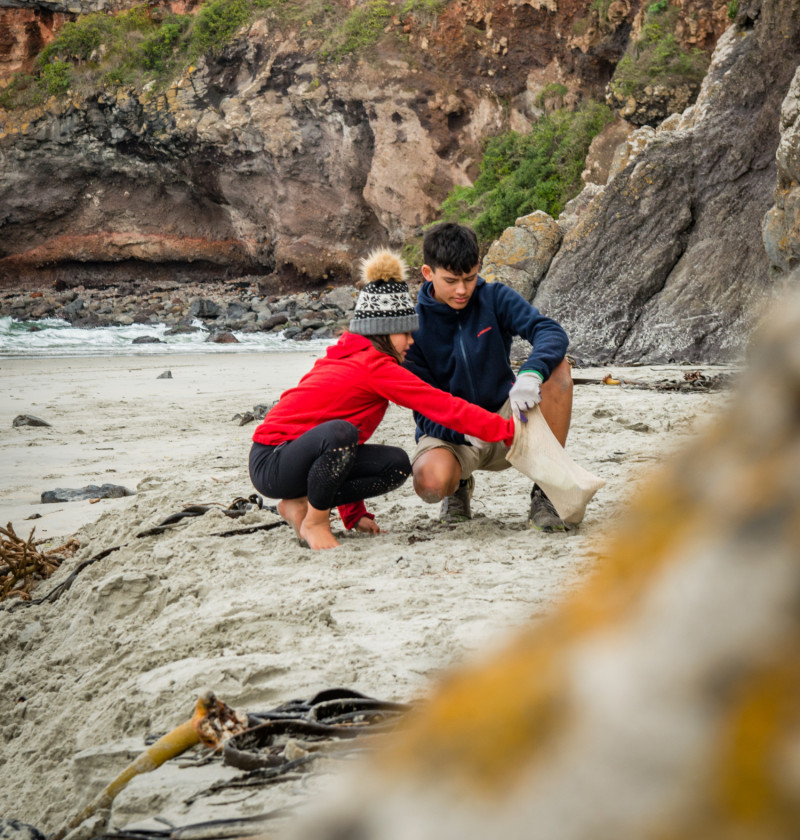
Download a PDF version of this chapter [PDF, 2.4 MB]
By 2050, Aotearoa has a circular economy that keeps materials in use for as long as possible. The waste sector has contributed to the 2030 and 2050 targets for biogenic methane, and achieved a 40 per cent reduction by 2035 (relative to 2017 levels). The sector has also met successive sub-sector targets.*
|
Projected emissions without the initiatives in this plan |
14.4 Mt CO2-e |
|
Projected average annual emissions without the initiatives in this plan |
3.5 Mt CO2-e |
|
Projected percentage of total gross emissions without the initiatives in this plan |
4 per cent |
|
Estimated emissions reduction from the initiatives in this plan |
0.2 to 0.4 Mt CO2-e |
In 2019, 94 per cent of waste emissions were biogenic methane – largely generated by the decomposition of organic waste (such as, food, garden, wood and paper waste).** While waste contributes a small percentage of our total emissions, biogenic methane has a warming effect 28 times greater than carbon dioxide.***
Taking steps to reduce, recycle and recover greater volumes of organic waste – and improve services and infrastructure – will also create opportunities. These steps will support the shift to a circular economy, create new employment and business opportunities, improve the ability to dispose of waste responsibly, and generate cost savings for households and businesses
* The Government has also committed to a waste sector sub-target of 13.7 Mt CO2-e over the first emissions budget period (2022–25). For more information, see chapter 1: Playing our part.
** In 2019, the main sources of waste emissions were from the organic waste that is part of solid waste disposal (82 per cent), followed by wastewater treatment (11 per cent), incineration and open burning (5 per cent), and biological treatment of solid waste (compost) (2 per cent). These figures are based on the latest greenhouse gas inventory adjusted to AR5 terms.
*** This statement is based on information in the Fifth Assessment Report of the United Nations Intergovernmental Panel on Climate Change [IPCC website], completed in 2014.
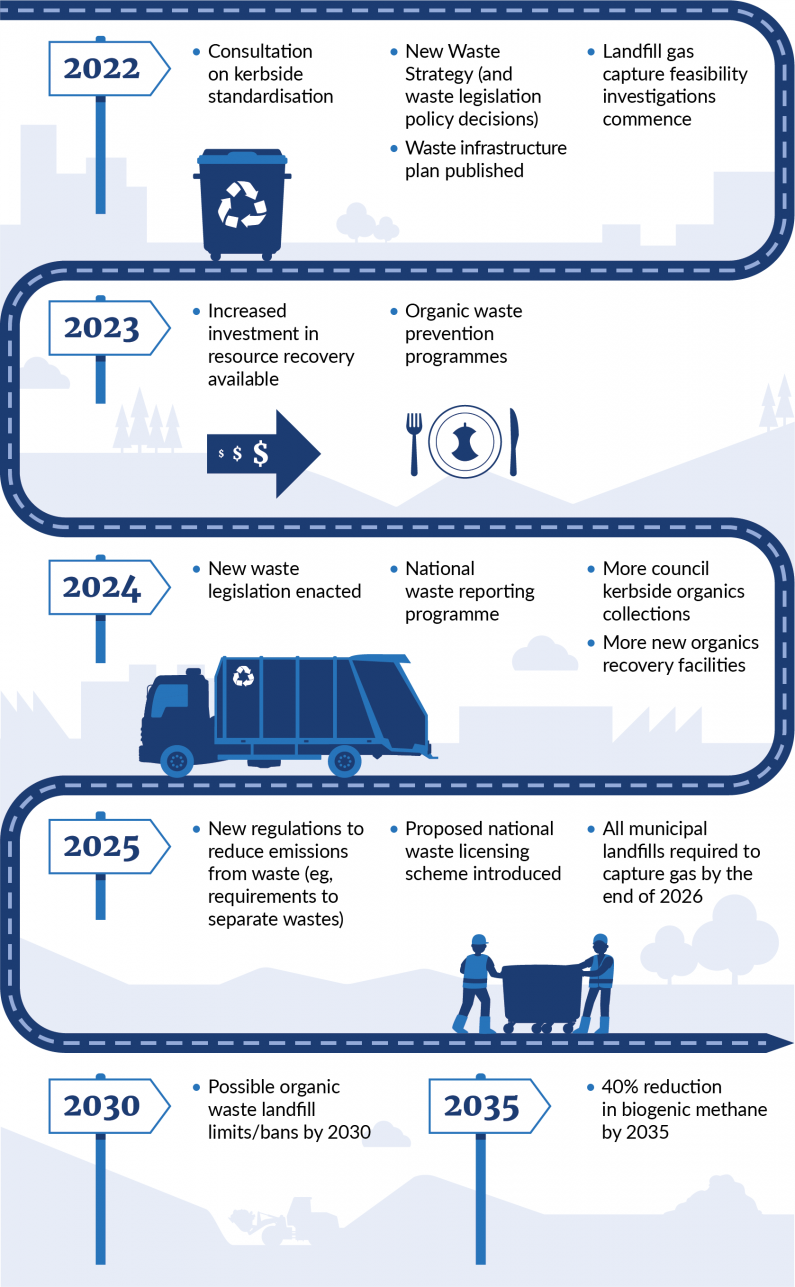
2022
2023
2024
2025
2030
2035
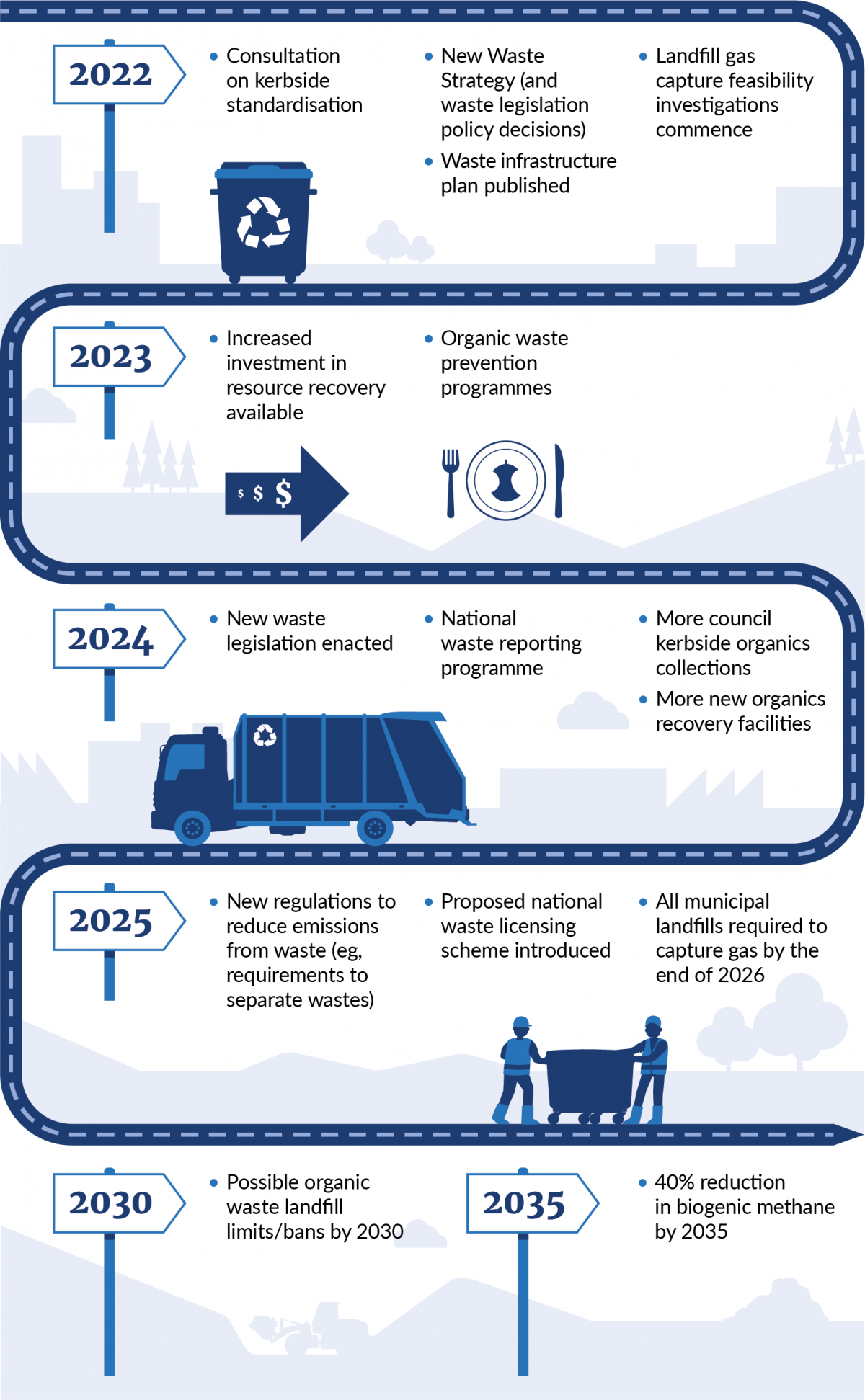
2022
2023
2024
2025
2030
2035
While waste contributes a comparatively small share of emissions, our path to a low-emissions future will support bigger shifts and yield multiple benefits – including enabling emissions reductions in other sectors.
We are working towards an Aotearoa where we waste less. This means making waste is avoided, and discarded organic materials – such as food and garden waste, paper and cardboard, and timber – are used as resources in a circular economy.
In this future, emissions from waste are minimised, captured and – wherever possible – used for beneficial purposes (eg, biogenic methane from landfills is used to generate electricity).
Changing the way we think about waste, alongside improving our services and waste infrastructure, will enable communities and businesses to build resilience. There are also economic opportunities for businesses and communities from more efficient use of materials that also reduce waste.
In 2019, waste was responsible for 4 per cent of our total gross emissions. Of these emissions, 94 per cent were biogenic methane generated by the decomposition of organic materials at landfill.*
While agriculture contributes the bulk of our biogenic methane emissions (91 per cent), waste has a role to play in meeting the 2030 and 2050 targets for biogenic methane.**
* The remaining emissions were nitrous oxide (4 per cent) and carbon dioxide (2 per cent).
** In 2019, the agriculture sector contributed around 91 per cent of our total biogenic methane. The remaining 9 per cent came from the waste sector.
Wide-ranging changes to the strategic framework for waste will set goals and priorities for the next 10, 20 and 30 years, guide investment, and enable systemic shifts.
The Government already has initiatives underway to reduce waste and emissions, including changes to the waste disposal levy, new regulated product stewardship schemes,** and the Waste Minimisation Fund. For more information on the Government’s broader approach to waste minimisation, see the waste reduction work programme.
* These principles – which also underpin actions to reduce emissions from waste – include (a) recognising the perspectives of local communities, businesses, hapū, iwi and whānau; (b) considering who bears the cost of change and addressing inequity; (c) developing and investing to create opportunities and build resilience; and (d) identifying and fixing problems now to avoid an unfair burden on future generations.
** Six product groups were declared a priority in July 2020, including synthetic greenhouse gases (see chapter 16: Fluorinated gases) and electrical and electronic products (which includes large batteries, such as those used in electric vehicles).
To reduce waste emissions, we need to focus on organic waste. This includes anything that contains degradable organic carbon – for example, materials like food and garden waste, paper, cardboard and timber.*
Our plans to reduce emissions fall into broad categories of the waste hierarchy:
recycle – divert organic waste to beneficial uses so that it is not sent to landfill
recover – reduce emissions from organic waste when it does end up in a landfill – capture biogenic methane emissions for energy.
* Future emissions reduction plans may have a broader focus. For example, they may include initiatives to address emissions from farm fills and/or wastewater.

Best option — Rethink/redesign
Avoid unnecessary resource use and waste by designing waste out
Reduce
Reduce the quantity, toxicity and ecological footprint of consumption
Reuse/repurpose
Reuse or repurpose products and components for the same purpose, or repurpose them for another use that does not reduce their value or require further processing
Recycle/compost anaerobic digestion
Recycle/compost – recover and process materials to make the same or different materials of similar value when reuse is no longer possible
Recover
Recover value (eg, energy) from materials that cannot be reused or recycled
Least favoured option — Treat and dispose
Treat the waste with processes to remove or reduce potential harm before disposing of the waste safely on land set aside for that purpose
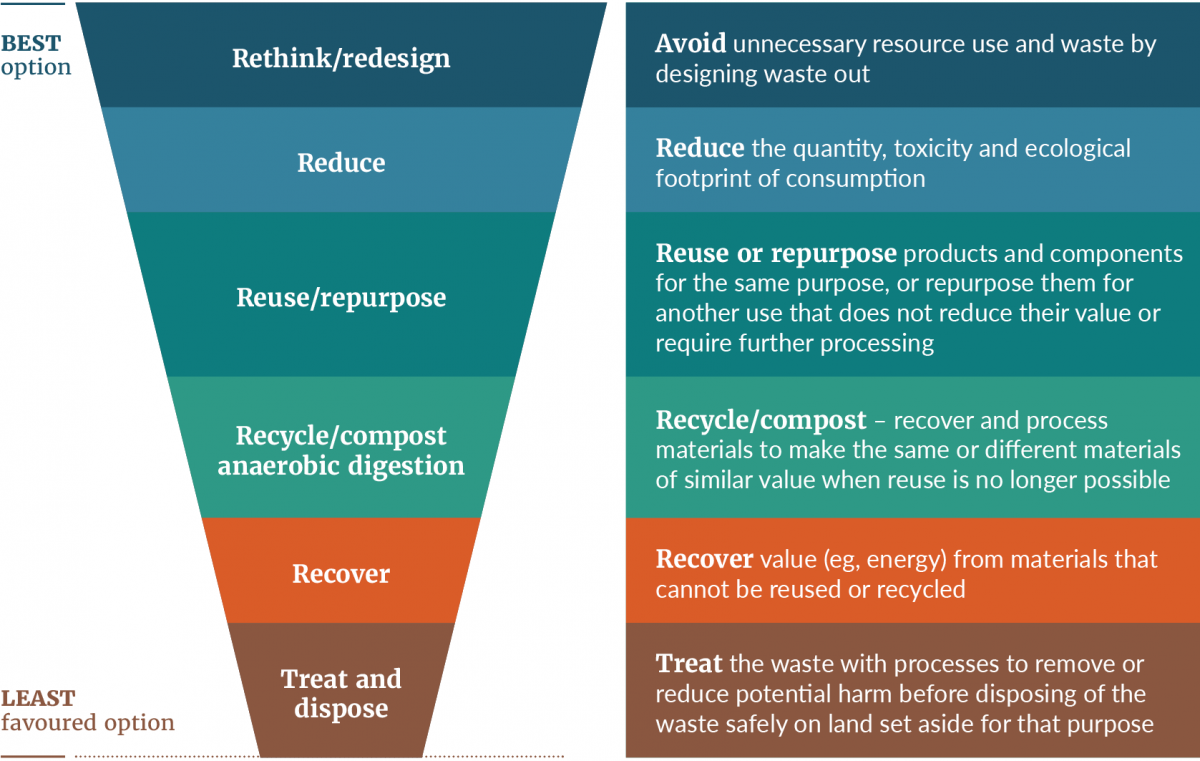
Best option — Rethink/redesign
Avoid unnecessary resource use and waste by designing waste out
Reduce
Reduce the quantity, toxicity and ecological footprint of consumption
Reuse/repurpose
Reuse or repurpose products and components for the same purpose, or repurpose them for another use that does not reduce their value or require further processing
Recycle/compost anaerobic digestion
Recycle/compost – recover and process materials to make the same or different materials of similar value when reuse is no longer possible
Recover
Recover value (eg, energy) from materials that cannot be reused or recycled
Least favoured option — Treat and dispose
Treat the waste with processes to remove or reduce potential harm before disposing of the waste safely on land set aside for that purpose
In several areas, actions will be informed by further consultation with local government, sector stakeholders, communities and – importantly – with Māori.
As new waste reduction policies and programmes are developed, the protection of Papatūānuku needs to be paramount. This means engaging with Māori to identify, understand and respond to Māori rights, interests and aspirations.
For example, this will involve:
Preventing organic waste has multiple benefits. It avoids emissions associated with the disposal of food and garden waste, and saves upstream emissions across the supply chain – from the production of food through to its consumption. For households and businesses, small changes can result in multiple benefits, including cost savings.*
* Reducing organic waste can lead to significant co-benefits. For example, households could save an average of NZ$644 a year by throwing away less edible food (see Don’t let food go to waste on the Love Food Hate Waste website). Restaurants and cafes may also see reduced costs by, for example, using better stock management or storage, using non-traditional parts of ingredients and reducing plate waste.
Households can prevent and reduce food and garden waste in several ways. Small changes can have an impact – for example, food waste can be reduced through meal planning, food preparation and storage. In the garden, green waste can be reduced through low-cost, home-based solutions (eg, composting, planting and mowing techniques).
Businesses can take steps to prevent food waste, save money* and support manufacturing, retail and hospitality sectors across the food supply chain.
* One study from the United Kingdom found that “for every $1 (or other relevant currency) invested in food loss and waste reduction, the median company site realized a $14 return”.
The business case for reducing food loss and waste: A report on behalf of Champions 12.3 [PDF, 691 KB]
Providing the services and infrastructure for kerbside organic collections makes it easier for households to manage their organic waste in a responsible way. However, the success of these collections relies on households using them correctly.
Organic material – such as food or garden waste – does not need to go to landfill. Instead, it can be used for other purposes. For example, food waste can be turned into compost (or other soil amendment products), used as stock food or used to generate energy through anaerobic digestion. Other edible food waste can be donated to food rescue groups.
This diversion has wide-ranging benefits, including job creation for the circular economy.* It can:
Reuse, redistribution, recycling and recovery can all result in a range of social, economic and environmental benefits. The relative benefits need to be carefully assessed when determining how best to divert organic waste.
To ensure that the shift to greater resource recovery is equitable, the Government will also continue to engage with the resource recovery sector to encourage training and skills development. The following actions can help to address inequity by supporting infrastructure development for organic waste diversion in areas less well serviced.
* Transforming our waste and resource recovery infrastructure is likely to have a positive effect on the workforce overall. Studies show that – on average – for every five jobs in landfilling, 15 to 20 jobs could be created in resource recovery.
See Reducing waste: a more effective landfill levy consultation document [PDF, 2.5 MB]
** In New Zealand, food rescue organisations redistribute around 8,000 tonnes of food each year.
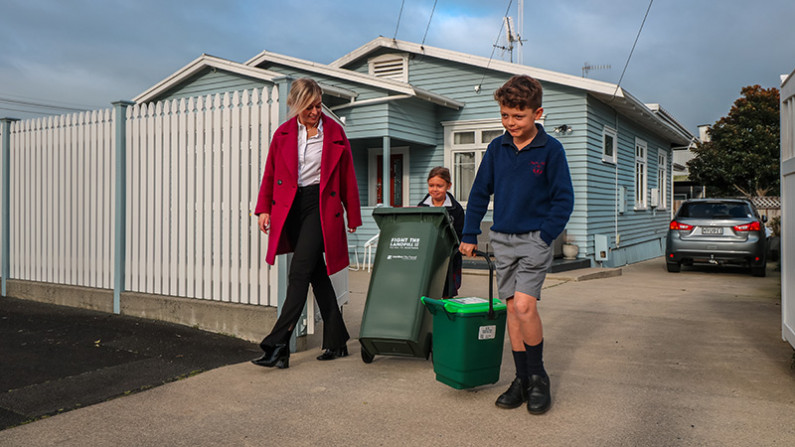
By 2024, Hamilton City Council aims to achieve a 10 per cent reduction in the amount of waste each person sends to landfill. This goal – established in 2017 – is part of the council’s Waste Minimisation and Management Plan.
Food scraps made up more than a third of household waste collected at the kerbside. To divert this organic waste from landfill, the council rolled out a city-wide, rates-funded ‘Para Kai’ kerbside collection of household food scraps. The weekly collection began in 2020 and is serviced by a fleet of specialised collection trucks, half of which are electric.
Food scraps are taken to the Hampton Downs composting plant, mixed with garden waste collected from residential drop-off points, and processed over 12 weeks to produce compost.
The compost is sold to commercial businesses, used for community projects, and residents can buy it for use in their gardens.
So far, over half of eligible properties have been using the food waste service. In just over a year, some 8,073 tonnes of food waste have been diverted from landfills.
Kerbside collections for food and garden waste services, as well as home and community composting programmes, enable New Zealanders to manage their organic waste responsibly, rather than sending it to landfill.
While many councils offer home composting programmes for households and a growing number offer separate kerbisde collections for food and/or garden waste, the availability of these services varies from district to district.
The collection of organic waste – such as food and garden waste, paper, cardboard and wood waste – must be supported by appropriate processing and resource recovery infrastructure.
Improving the recovery and diversion of organic waste in Aotearoa will require new infrastructure and upgrades to existing infrastructure (eg, transfer stations). This infrastructure will support our move to a more circular economy, in which less organic waste enters landfills – and more inorganic resources are recovered (eg, metals, plastics and glass).
Business food scrap collections are only available in some parts of the country. Where they do exist, there are several barriers that stop businesses using them. These can include higher costs, less convenience, and the need for property owners or body corporates to agree. A lack of services is often due to a lack of nearby processing facilities.
Requiring businesses to separate food scraps would encourage more providers and processors to enter the market. It could also motivate businesses to look for ways to reduce food waste in their general rubbish, including by donating to food rescue organisations.
Organic materials – including treated timber, untreated timber and other composite products – are used extensively in our construction sector. With residential and commercial development on the rise, this brings an increase in construction and demolition (C&D) waste. Growth in construction activities and material costs provides an incentive to reduce, reuse and recycle key materials.
We need to increase the recovery and reuse of these C&D materials, rather than disposing of them to landfill, where they can generate greenhouse gas emissions. This will be done through additional research, sector support, investment in resource recovery processing infrastructure and consideration of future regulation for waste separation.
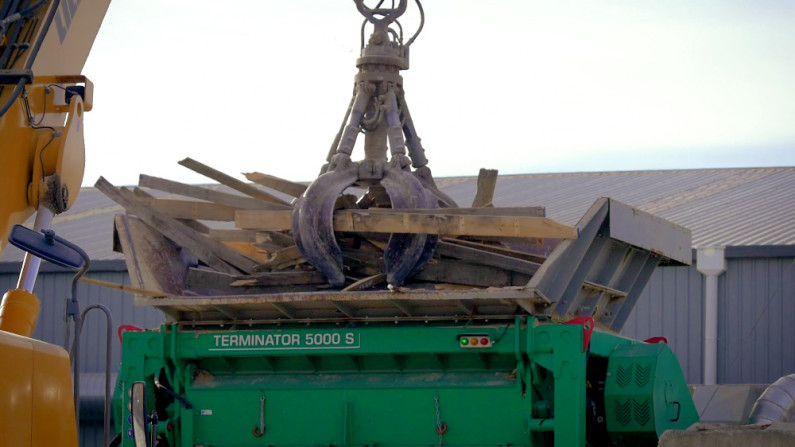
C&D material is the largest source of waste going to municipal landfills. In Auckland, nearly 570,000 tonnes of C&D waste goes to landfill each year. A Kiwi-owned company, Green Gorilla, is tackling this significant waste stream. To do this, they have received over NZ$5 million in financial support from the Waste Minimisation Fund.
Green Gorilla process about 6,000 tonnes of C&D waste each month in their custom-built waste processing facility in Onehunga, which opened in 2012. Around 75 per cent of the C&D materials Green Gorilla processes are diverted from Auckland landfills for recycling on-site or supplied to other organisations for recycling or reuse.
Waste timber is a large component of the C&D waste received (20 to 30 per cent) and contributes to greenhouse gas emissions in landfills. Green Gorilla diverts treated and non-treated timber by separating it out and processing it into products such as biofuel, landscaping wood chip, and animal bedding. Green Gorilla also collects and processes steel, paper and gypsum.
Over time, an increase in green building techniques in the construction industry and efforts to design out waste will reduce C&D waste. In the meantime, the construction industry continues to produce vast amounts of materials that can be readily recycled and diverted.
Greater quantities of C&D waste – including wood waste – could be diverted from landfill.
Wood waste is a mixture of products from the construction industry. Untreated timber, when identifiable, can be more easily reused (native timber in particular) or used as a feedstock for fuel production. Treated timber, on the other hand, forms a large proportion of C&D waste and is more difficult to manage.*
* It is possible to burn or otherwise process treated wood for energy. Yet doing so remains a challenge, as there are risks that extremely harmful toxins (such as arsenic) may be emitted and/or concentrated into hard-to-manage hazardous waste streams if treated wood is not appropriately managed.
Diverting and recovering greater volumes of construction materials could generate savings and emissions reductions in other parts of the economy. For example, separating out organic material streams, such as timber, could also facilitate the separation of inorganic materials (such as concrete and steel). By increasingly recovering and reusing these materials, we could reduce the need to produce and use new materials, and avoid associated emissions.
Improving the separation of organic materials will support the diversion of waste from landfill and enable increased recovery of construction and demolition waste, such as treated and non-treated timber products.
In order to reduce emissions in line with the waste sector sub-target, modelling suggests that it may be necessary to limit or ban disposal of all or some types of organic materials to landfill by 2030.
Banning organic materials from a range of landfill types would also incentivise businesses and households to look for ways to reduce or recycle/compost their organic waste. Any ban would ideally be supported by data, detailed research, and enabling infrastructure – providing a reasonably practicable alternative to disposal. Without viable alternatives, there is a risk of perverse outcomes, such as stockpiling, illegal disposal and levy avoidance.
Landfill gas (LFG) is a by-product of decomposing organic waste in landfills. It is mainly composed of biogenic methane and carbon dioxide. With the appropriate equipment, modern landfills can capture some of the gas and either flare (burn) it or use it to produce energy. The process converts the biogenic methane to carbon dioxide, which has a lesser impact.
Capturing LFG is a valid way to reduce harmful biogenic methane emissions and, in some cases, gain added benefits. However, it is not a perfect solution. Improving LFG capture does not encourage the recovery of organic materials and – because of practical and economic limitations – still results in some biogenic methane emissions.*
* On average, the latest New Zealand greenhouse gas inventory assumes the lifetime efficiency of LFG capture at open landfills as 68 per cent.
Read New Zealand’s Greenhouse Gas Inventory 1990–2019 [PDF, 9.5 MB], at p. 377.
Increasing the amount of biogenic methane captured at municipal (Class 1) landfills will require capture systems to be installed (where feasible). Municipal landfills receive organic waste from households and businesses mixed with rubbish. Sites without LFG capture could be banned from receiving organic waste.
* The Government intends to enact this requirement by lowering the threshold and related provisions under the National Environmental Standards for Air Quality (or its equivalent under new resource management legislation), or potentially using new tools under revised waste legislation.
See the National environmental standards for air quality
Includes a link to the Resource Management (National Environmental Standards for Air Quality) Regulations 2004 [New Zealand Legislation website]
A phased approach will provide time for the sector to adapt and for research into whether additional LFG capture requirements or organic material bans should be implemented.
As noted in action 15.5.1, the first phase will require LFG capture at all municipal (Class 1) landfills by 31 December 2026. This will allow time to improve enabling systems and infrastructure. It will also provide time to assess whether similar requirements should be applied to non-municipal (Classes 2 to 5) landfills that receive less organic waste.
Future emissions reduction policies rely on having quality data on emissions and the waste materials that produce them. Currently our waste data has high levels of uncertainty. This applies to managed landfills, where there is a lack of information about waste composition and LFG capture rates. The data gaps and uncertainties are even greater for other waste disposal types (such as unmanaged fills, farm fills, composting and wastewater).*
* For Class 2 to 5 landfills, data uncertainty is estimated to be ±140 per cent.
A national licensing scheme allows more coordinated and efficient data collection and management of the effects of waste, including emissions. A national scheme would build a better evidence base to help prioritise and measure actions to minimise waste and reduce emissions in Aotearoa.
Changes to the waste disposal levy have extended tonnage reporting requirements to all landfills and to transfer stations and are set in regulation. Future data reporting includes requirements for landfill operators, transfer station operators and territorial authorities to report the activity that generated the waste received.* In addition, a new national data collection and reporting programme on emissions reductions from waste is planned.
Improving waste data and building our understanding of waste sector emissions will help to identify future opportunities, including those around farm fills and wastewater treatment.
* These reporting requirements will be introduced as part of the expansion of the waste disposal levy.
Waste emissions are expected to be reduced. This emissions reduction plan describes the policies and potential pathway to reducing organic waste disposal emissions in Aotearoa.
Figure 15.3 shows that in a ‘do everything’ scenario the sum of the waste policies comes close to achieving the pathway necessary to meet the first waste sector sub-target (2022–25). This scenario also indicates that greater emissions reductions from 2026–35 will mean the waste sector comes very close to achieving its provisional sector sub-targets for the second and third emissions budget periods.
While the waste sector is initially expected to fall short to 2025, improving our evidence base will support the development of future interventions.
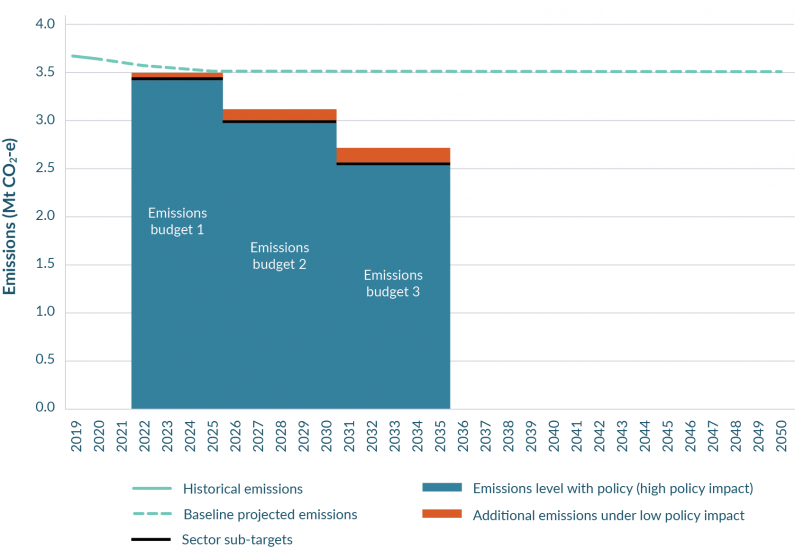
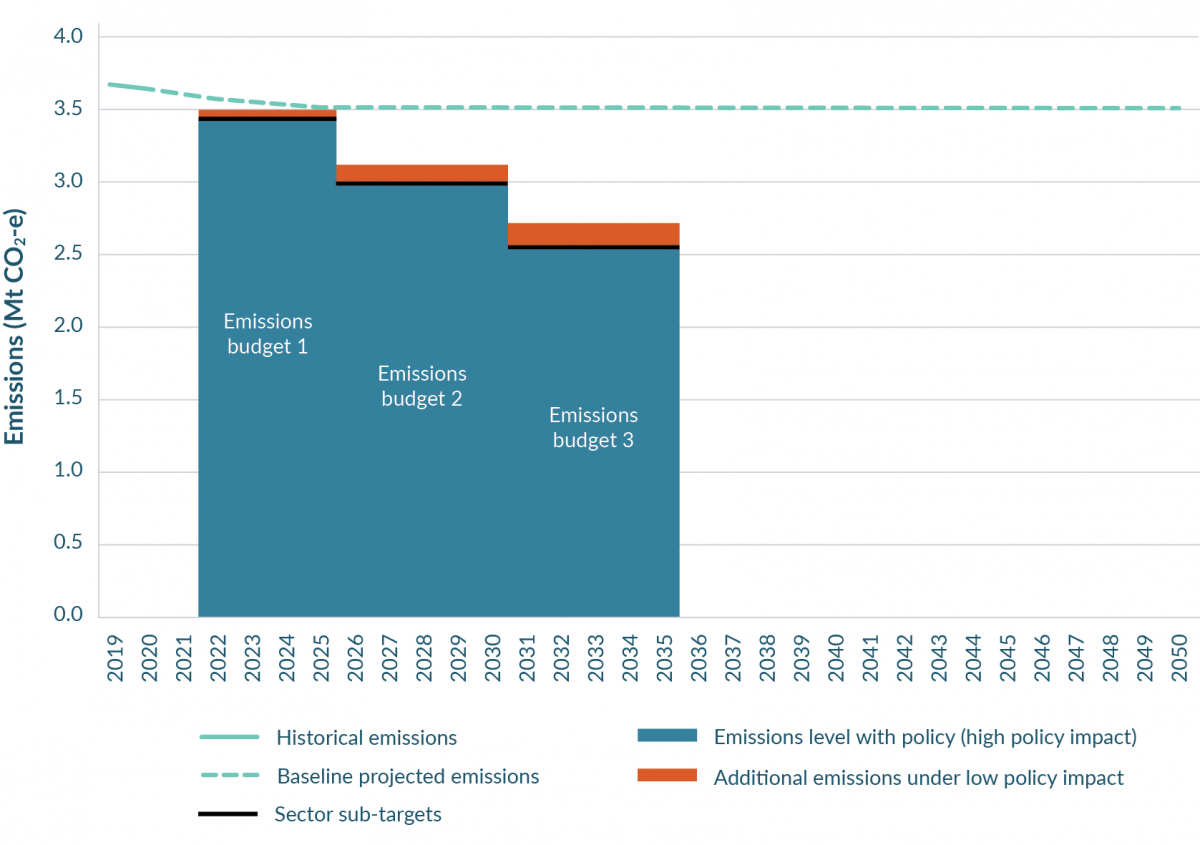
Note 1: Modelled impacts have varying degrees of uncertainty and, for completeness, figure 15.3 shows all sources of waste emissions, including those that produce more of the other greenhouse gases such as carbon dioxide and nitrous oxide.
Note 2: This model is based on a cumulative policies scenario that assumes:
* This assumes 40 per cent of food waste diverted to composting (20 per cent window and 20 per cent in-vessel composting, or IVC) and 60 per cent to anaerobic digestion. It also assumes 100 per cent of diverted green waste to composting (60 per cent compost and 40 per cent IVC). In practice the best processing option should be selected based on availability of waste types and markets for potential products.
We all create waste and we can all help reduce the emissions it generates.
Resource recovery infrastructure to collect and process household waste has been largely led by local government. Councils will need to provide services, such as kerbside collections and related infrastructure, that enable us to reduce and recycle organic waste. New Zealanders should be able to recycle organic waste responsibly no matter where they live.
In addition to local government, the private sector (in this case, waste and recycling companies and landfill operators) also has a key role in supporting the provision of resource recovery infrastructure, participating in national licensing and waste data collection, and implementing LFG capture systems. Businesses across the supply chain will need to design out waste and look for innovative opportunities to reuse and recycle resources.
Individuals and communities can also help to reduce waste and emissions from waste. Individuals can make personal efforts to avoid creating waste in the first place, compost at home or use collection services. At a community level, groups can lead waste minimisation education, operate local recycling centres and advocate for change.
With the right support from government, partnerships and clear direction, there is significant scope for local government, Māori, community agencies and the private sector to invest in the transition to a low-emissions, low-waste future.
Climate change effects, such as sea-level rise, flooding, temperature rise and the risk of wildfires, have the potential to negatively impact on waste infrastructure and disposal sites.
Flooding can have compounding effects for waste. For example, flooding can result in house-loads of damaged material being disposed to landfill, as well as contaminated waste. Severe weather events can also lead to beaches and waterways littered with contaminated and hazardous materials, creating risks for human health and the environment.
Failing to adequately prepare for and build resilience to climate impacts, can put waste recovery services under pressure and reduce the capacity to recover materials.
There is also a risk that contaminants will be discharged from disposal sites, affecting water quality. For Māori, this degrades the mauri of waterways, contaminates mahinga kai (food-gathering areas), affects taonga species, and is likely to impact cultural practices.
Some landfills (active and closed) and contaminated sites are considered vulnerable, as they are situated in high-risk flood and erosion prone areas.
The risk to human health and the environment from vulnerable landfills and contaminated sites is moderate at present but will likely increase.
As a result, the development and implementation of waste policy needs to consider:
The upcoming national adaptation plan will be published in late-2022 and will include actions to respond to the risk posed by vulnerable landfills and contaminated sites.

Chapter 15 Waste
May 2022
© Ministry for the Environment